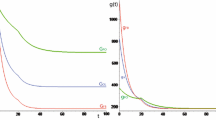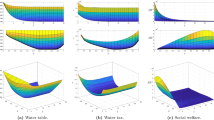Abstract
Groundwater is a common resource that has been wasted for years. Today, we pay the consequences of such inappropriate exploitation and we are aware that it is necessary to realize policies in order to guarantee the use of this resource for future generations. In fact, the irrational exploitation of water by agents, nevertheless it is a renewable resource, may cause its exhaustion. In our paper, we develop a differential game to determine the efficient extraction of groundwater resource among overlapping generations. We consider intragenerational as well as intergenerational competition between extractors that exploit the resource in different time intervals, and so the horizons of the players in the game are asynchronous. Feedback equilibria have been computed in order to determine the optimal extraction rate of “young” and “old” agents that coexist in the economy. The effects of the withdrawal by several generations are numerically and graphically analyzed in order to obtain results on the efficiency of the groundwater resource.





Similar content being viewed by others
References
Banker, R.D.: A game theoretic approach to measuring efficiency. Eur. J. Oper. Res. 5(4), 262–268 (1980)
Banker, R.D., Charnes, A., Cooper, W.W., Clarke, R.: Constrained game formulation and interpretations for data envelopment analysis. Eur. J. Oper. Res. 40(3), 299–308 (1989)
Basar, T., Olsder, G.J.: Dynamic Noncooperative Game Theory. Academic Press, New York (1995)
Biancardi, M., Maddalena, L.: Competition and cooperation in the exploitation of the groudwater resource. Decis. Econ. Finance 41(2), 219–237 (2018)
Biancardi, M., Maddalena, L.: Groundwater management and agriculture. In: International Scientific Conference on IT, Tourism, Economics, Management and Agriculture (2019)
Burton, P.: Intertemporal preferences and intergenerational equity considerations in optimal resources harvesting. J. Environ. Econ. Manag. 24(2), 119–132 (1993)
Carrera, C., Moran, M.: General dynamics in overlapping generations models. J. Econ. Dyn. Control 19(4), 813–830 (1995)
Chiarella, C., Kemp, M.C., Long, N.V., Okuguchi, K.: On the economics of international fisheries. Int. Econ. Rev. 25, 85–92 (1984)
Clemhout, S., Wan, HJr: Dynamic common property resources and environmental problems. J. Optim. Theory Appl. 46, 471–481 (1985)
Esteban, E., Albiac, J.: Groundwater and ecosystems damages: questioning the Gisser–Sanchez effect. Ecol. Econ. 70(11), 2062–2069 (2011)
Gisser, M., Sanchez, D.A.: Competition versus optimal control in groundwater pumping. Water Resour. Res. 16(4), 638–642 (1980)
Grilli, L.: Resource extraction activity: an intergenerational approach. In: Petrosjan, M. (ed.) Game Theory and Applications, vol. 13, pp. 45–55. Nova Science Publishers, Hauppauge (2008)
Jørgensen, S., Yeung, D.: Stochastic differential game model of a common property fishery. J. Optim. Theory Appl. 90(2), 391–403 (1996)
Jørgensen, S., Yeung, D.W.K.: Inter-and intragenerational renewable resource extraction. Ann. Oper. Res. 88, 275–289 (1999)
Kaitala, V.: Equilibria in a stochastic resource management game under imperfect information. Eur. J. Oper. Res. 71(3), 439–453 (1993)
Koundouri, P.: Current issues in the economics of groundwater resource management. J. Econ. Surv. 18(5), 703–740 (2004)
Mourmouras, A.: Conservationist government policies and intergenerational equity in an overlapping generations model with renewable resources. J. Public Econ. 51(2), 249–268 (1993)
Negri, D.H.: The common property aquifer as a differential game. Water Resour. Res. 25(1), 9–15 (1989)
Provencher, B., Burt, O.: The externalities associated with the common property exploitation of groundwater. J. Environ. Econ. Manag. 24(2), 139–158 (1993)
Rubio, S.J., Casino, B.: Competitive versus efficient extraction of a common property resource. The groundwater case. J. Econ. Dyn. Control 25(8), 1117–1137 (2001)
Rubio, S.J., Casino, B.: Strategic behavior and efficiency in the common property extraction of groundwater. Environ. Resource Econ. 26, 73–87 (2003)
Author information
Authors and Affiliations
Corresponding author
Additional information
Publisher's Note
Springer Nature remains neutral with regard to jurisdictional claims in published maps and institutional affiliations.
Appendix A
Appendix A
Performing the maximization problem in Eqs. (11) and (12) with respect to \(w_i^j\) and \(w_i^{j-1}\), for \(t\,\in \,[t_j,t_j+T/2]\), we obtain:
and
Adding in Eqs. (25) and (26) over all extractors living in the time interval \([t_j, t_j + T/2]\), that is, all the n “young” agents for the generation j and the n “old” agents for the generation \(j-1\), we obtain:
for all ith extractor in the jth generation and
for all ith extractor in the \(j-1\)th generation. Equations (27) and (28) represent a system of linear equations in \(\phi _i^{j*}(H,t)\) and \(\phi _i^{j-1**}(H,t)\). The system admits a unique solution:
Substituting Eqs. (29) and (30) into HJB given by Eqs. (11) and (12), we obtain the following system of partial differential equations (dropping for notational convenience the (H, t) arguments of the value functions):
Rearranging Eqs. (31) and (32), we obtain that:
and
where
Rights and permissions
About this article
Cite this article
Biancardi, M., Maddalena, L. & Villani, G. Groundwater extraction among overlapping generations: a differential game approach. Decisions Econ Finan 43, 539–556 (2020). https://doi.org/10.1007/s10203-020-00292-w
Received:
Accepted:
Published:
Issue Date:
DOI: https://doi.org/10.1007/s10203-020-00292-w




